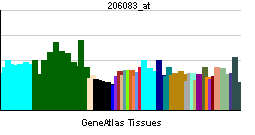Brain-specific angiogenesis inhibitor 1
| Brain-specific angiogenesis inhibitor 1 | |||||||||||
|---|---|---|---|---|---|---|---|---|---|---|---|
| Identifiers | |||||||||||
| Symbols | BAI1 ; FLJ41988 | ||||||||||
| External IDs | Template:OMIM5 Template:MGI HomoloGene: 1287 | ||||||||||
| |||||||||||
| RNA expression pattern | |||||||||||
 | |||||||||||
| More reference expression data | |||||||||||
| Orthologs | |||||||||||
| Template:GNF Ortholog box | |||||||||||
| Species | Human | Mouse | |||||||||
| Entrez | n/a | n/a | |||||||||
| Ensembl | n/a | n/a | |||||||||
| UniProt | n/a | n/a | |||||||||
| RefSeq (mRNA) | n/a | n/a | |||||||||
| RefSeq (protein) | n/a | n/a | |||||||||
| Location (UCSC) | n/a | n/a | |||||||||
| PubMed search | n/a | n/a | |||||||||
Brain-specific angiogenesis inhibitor 1, also known as BAI1, is a human gene.[1]
Angiogenesis is controlled by a local balance between stimulators and inhibitors of new vessel growth and is suppressed under normal physiologic conditions. Angiogenesis has been shown to be essential for growth and metastasis of solid tumors. In order to obtain blood supply for their growth, tumor cells are potently angiogenic and attract new vessels as results of increased secretion of inducers and decreased production of endogenous negative regulators. BAI1 contains at least one 'functional' p53-binding site within an intron, and its expression has been shown to be induced by wildtype p53. There are two other brain-specific angiogenesis inhibitor genes, designated BAI2 and BAI3 which along with BAI1 have similar tissue specificities and structures, however only BAI1 is transcriptionally regulated by p53. BAI1 is postulated to be a member of the secretin receptor family, an inhibitor of angiogenesis and a growth suppressor of glioblastomas[1]
References
Further reading
- Van Meir EG, Polverini PJ, Chazin VR; et al. (1995). "Release of an inhibitor of angiogenesis upon induction of wild type p53 expression in glioblastoma cells". Nat. Genet. 8 (2): 171–6. doi:10.1038/ng1094-171. PMID 7531056.
- Nishimori H, Shiratsuchi T, Urano T; et al. (1997). "A novel brain-specific p53-target gene, BAI1, containing thrombospondin type 1 repeats inhibits experimental angiogenesis". Oncogene. 15 (18): 2145–50. PMID 9393972.
- Shiratsuchi T, Nishimori H, Ichise H; et al. (1998). "Cloning and characterization of BAI2 and BAI3, novel genes homologous to brain-specific angiogenesis inhibitor 1 (BAI1)". Cytogenet. Cell Genet. 79 (1–2): 103–8. PMID 9533023.
- Shiratsuchi T, Futamura M, Oda K; et al. (1998). "Cloning and characterization of BAI-associated protein 1: a PDZ domain-containing protein that interacts with BAI1". Biochem. Biophys. Res. Commun. 247 (3): 597–604. doi:10.1006/bbrc.1998.8603. PMID 9647739.
- Fukushima Y, Oshika Y, Tsuchida T; et al. (1998). "Brain-specific angiogenesis inhibitor 1 expression is inversely correlated with vascularity and distant metastasis of colorectal cancer". Int. J. Oncol. 13 (5): 967–70. PMID 9772287.
- Shiratsuchi T, Oda K, Nishimori H; et al. (1998). "Cloning and characterization of BAP3 (BAI-associated protein 3), a C2 domain-containing protein that interacts with BAI1". Biochem. Biophys. Res. Commun. 251 (1): 158–65. doi:10.1006/bbrc.1998.9408. PMID 9790924.
- Oda K, Shiratsuchi T, Nishimori H; et al. (1999). "Identification of BAIAP2 (BAI-associated protein 2), a novel human homologue of hamster IRSp53, whose SH3 domain interacts with the cytoplasmic domain of BAI1". Cytogenet. Cell Genet. 84 (1–2): 75–82. PMID 10343108.
- Wu Y, Dowbenko D, Spencer S; et al. (2000). "Interaction of the tumor suppressor PTEN/MMAC with a PDZ domain of MAGI3, a novel membrane-associated guanylate kinase". J. Biol. Chem. 275 (28): 21477–85. doi:10.1074/jbc.M909741199. PMID 10748157.
- Koh JT, Lee ZH, Ahn KY; et al. (2001). "Characterization of mouse brain-specific angiogenesis inhibitor 1 (BAI1) and phytanoyl-CoA alpha-hydroxylase-associated protein 1, a novel BAI1-binding protein". Brain Res. Mol. Brain Res. 87 (2): 223–37. PMID 11245925.
- Duda DG, Sunamura M, Lozonschi L; et al. (2002). "Overexpression of the p53-inducible brain-specific angiogenesis inhibitor 1 suppresses efficiently tumour angiogenesis". Br. J. Cancer. 86 (3): 490–6. doi:10.1038/sj.bjc.6600067. PMID 11875720.
- Lim IA, Hall DD, Hell JW (2002). "Selectivity and promiscuity of the first and second PDZ domains of PSD-95 and synapse-associated protein 102". J. Biol. Chem. 277 (24): 21697–711. doi:10.1074/jbc.M112339200. PMID 11937501.
- Mori K, Kanemura Y, Fujikawa H; et al. (2002). "Brain-specific angiogenesis inhibitor 1 (BAI1) is expressed in human cerebral neuronal cells". Neurosci. Res. 43 (1): 69–74. PMID 12074842.
- Kaur B, Brat DJ, Calkins CC, Van Meir EG (2003). "Brain angiogenesis inhibitor 1 is differentially expressed in normal brain and glioblastoma independently of p53 expression". Am. J. Pathol. 162 (1): 19–27. PMID 12507886.
- Adkins JN, Varnum SM, Auberry KJ; et al. (2003). "Toward a human blood serum proteome: analysis by multidimensional separation coupled with mass spectrometry". Mol. Cell Proteomics. 1 (12): 947–55. PMID 12543931.
- Ota T, Suzuki Y, Nishikawa T; et al. (2004). "Complete sequencing and characterization of 21,243 full-length human cDNAs". Nat. Genet. 36 (1): 40–5. doi:10.1038/ng1285. PMID 14702039.
- Koh JT, Kook H, Kee HJ; et al. (2004). "Extracellular fragment of brain-specific angiogenesis inhibitor 1 suppresses endothelial cell proliferation by blocking alphavbeta5 integrin". Exp. Cell Res. 294 (1): 172–84. doi:10.1016/j.yexcr.2003.11.008. PMID 14980512.
- Bjarnadóttir TK, Fredriksson R, Höglund PJ; et al. (2005). "The human and mouse repertoire of the adhesion family of G-protein-coupled receptors". Genomics. 84 (1): 23–33. doi:10.1016/j.ygeno.2003.12.004. PMID 15203201.
This article incorporates text from the United States National Library of Medicine, which is in the public domain.